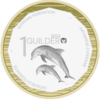Satavian guilder
| Asteriaans: Satawiese gulden Hennish: Satavisch gulden | |||||
|---|---|---|---|---|---|
| |||||
| ISO 4217 | |||||
| Unit | |||||
| Symbol | G | ||||
| Denominations | |||||
| Subunit | |||||
| 1:100 | cent | ||||
| Symbol | |||||
| cent | c | ||||
| Banknotes | |||||
| Freq. used | G5, G10, G20, G50, G100 | ||||
| Rarely used | No longer in use: G1, G2 | ||||
| Coins | |||||
| Freq. used | 5c, 10c, 20c, 50c, G1, G2 | ||||
| Rarely used | 1c, 2c | ||||
| Demographics | |||||
| Date of introduction | January 1, 1943 | ||||
| Replaced | Satavian shilling | ||||
| User(s) | |||||
| Issuance | |||||
| Central bank | Reserve Bank of Satavia | ||||
| Website | rbs | ||||
| Printer | Federal Printing Office | ||||
| Mint | Federal Estmerish Mint | ||||
| Website | mint | ||||
| Valuation | |||||
| Inflation | 5.5% | ||||
The Satavian guilder (Asteriaans: Satawiese gulden, Hennish: Satavisch gulden; sign G; code: SVG) is the official currency of Satavia, and is legal tender in Naua Roa.
Introduced in 1943, the Guilder replaced the Satavian shilling and is subdivided into 100 cents. The guilder has 8 coins and 5 banknotes, with the smallest being the 1-cent coin, which together with the 2-cent coin are still minted, although rarely used.
History
The Satavian guilder was introduced on January 1, 1943 as the decimalised replacement to the Satavian shilling. The shilling had utilised the £sd system, as was common in former colonies and territories of Estmere, which by 1943 was regarded as complicated and obsolete. The Satavian shilling remained legal tender in Satavia until January 1, 1946. The shilling was introduced by the National party government of Christiaan Pienaar. The National party had launched a coup in February 1939 that had removed the democratically elected government of Edward Limes, and as part of the new government's programme of 'decolonisation' (Satavia had only achieved independence from Estmere in 1936) the shilling was decimalised. The currency was renamed the Guilder (as it had been before Estmere seized control of Satavia in 1747) and was initially pegged to the Estmerish shilling at par, before it was devalued in 1959 to Sh1 = G1.5 and was again devalued in 1968 to Sh1 = G2.5. The guilder was floated in 1978, as part of the Liberal government's 'post-dictorship recovery plan'. During the financial crisis of 2005, the Reserve Bank of Satavia sold an undisclosed ammount of Satavian guilders in an unsuccessful attempt to drive down the Guilders value. In June 2008, the Reserve Bank began purchasing government bonds and a large selection of other financial assets in an attempt to increase inflation, which had began rapidly decreasing at the start of the year. The intervention is one of the only succesfull instances of quantitive easing.
As of July 2022, the SVG was trading at approximately €0.12.
Coins
History
Upon the introduction of the guilder, coins came in the denominations 1c, 2c, 5c, 10c, 20c, 50c. The 1c and 2c coins were copper, whilst the 5c, 10c, 20c and 50c coins were an alloy of silver and copper. All the coins featured the coat of arms of the Republic of Satavia on the obverse (replacing the head of a monarch which had previously been used on the shilling until 1936) whilst they often featured National party politicians on the reverse (such as Christiaan Pienaar who was featured on the 50c coin from 1947 until 1976). The only exception to this rule was the 10c, 20c and 50c coins minted in 1966, the 425th aniversary of the landings of Jan van Breybach at Sandy Cove, where the obverse featured a variety of Hennish and Asterianer symbols and emblems, whilst the reverse depicted Adriaan Pienaar, Jan van Breybach and Christiaan Matthys.
Coins minted from 1976 feature the coat of arms of Satavia on the reverse and a variety of different depictions of Satavia on the obverse, that have included fauna, architecture, 'great Satavians' and

